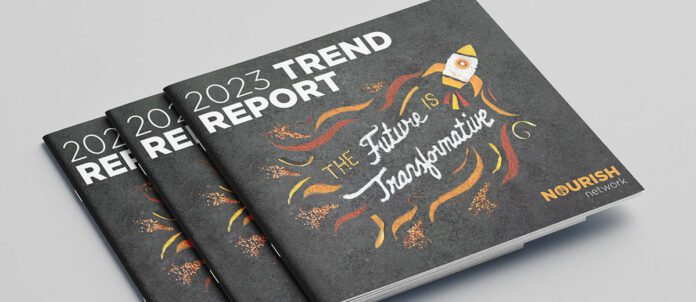TORONTO — Nourish Food Marketing, in collaboration with Kahntact Marketing, recently hosted a webinar to mark the release of its Trend Report 2023, which uncovers nine key trends shaping the food, beverage and agriculture landscapes in 2023 and beyond.
“You might say we’re on a launching pad,” said Jo-Ann McArthur, president of Nourish Food Marketing. “In 2023, we will see trends leaping into the future. It will take out-of-the-box thinking to solve the big issues we are facing. Consumers are demanding action and they do not want to go backwards and even slow progress will be seen as going backwards. The question is, are you ready to take these trends to future proof your business?”
This year’s trends include:
- The Rise of Reducatarianism: Trading “either/or” for “everything, but less”
Reducatarianism is all about reducing meat intake rather than cutting it out completely. “A diet blending animal and vegetable proteins results in a more affordable household and planetary budget,” said McArthur. “Consumers are becoming naturally less carnivorous due to climate change and animal-welfare concerns, but they’re not willing to compromise on taste.”
- Good Eats, Better Sleeps: The role of food as a sleep aid to promote overall well-being
“Boosting immunity was a focus during COVID-19 and one of our [previous trends], but it is sleep that’s the true foundation of health,” said McArthur. “Medical research now recognizes the connection between what you eat and the quality and quantity of your sleep and how it affects food choices and physical and mental well-being.”
Overall, McArthur said there are foods that are high in melatonin to aid sleep, such as berries and milk, which signals an opportunity to further explore the link between sleep and food and beverage.
- This One’s for the Ladies: Female food is a missed opportunity we can no longer overlook
“It’s time for female-specific food-and-beverage innovation,” said McArthur. “Opportunities are available at all life stages from cradle to grave due to hormonal differences, pregnancy, menstruation and menopause.”
McArthur went on to say that there are a lot of PMS teas on the market, but only a few other products to help with biology-driven food cravings. Some examples include Toronto-based Lactation Cookie Company, which supports breastfeeding mothers’ milk supply, and California-based Moodygirl Chocolate, which supports PMS symptoms.
- Food without Borders: Social media unites us globally so we can shop and cook together
Recipes and food trends are circulating through social channels more now than ever before. There are plenty of opportunities to participate in this trend.
“Anything that allows us to be more social and participate in shared experiences will always win,” said McArthur. “Food is a universal language, and now [we] can cook with people around the globe in a vast shared cultural experience. We see the merging and mixing of international food ingredients and preparation, allowing us to travel with our forks in our eyes to other kitchens worldwide.”
- Robots, AI and Connected Kitchens: The future of food automation finally arrives
Robots have become ubiquitous and indispensable on most modern farms and have also appeared in the home, retail and foodservice spaces.
McArthur pointed to a few examples, including smart carts at some Sobeys locations; unattended checkouts at Amazon Go stores; and self-contained units like Pizza Forno.
- Breaking the Chains: Localized production offers an alternative to shaky global supply chains
“Local food grew in importance with consumers who see it as a sign of quality and evidence that you’re supporting your community,” said McArthur. “It’s also part of food system resiliency as we enter a period of global unrest, logistics constraints and shifting economic partners, all coupled with climate change.”
Outdoor vertical farms are one example of a year-round locally-reliable food supply. In Canada, McArthur said the Weston Family Foundation has launched a $33 million homegrown innovation challenge to spark future-proof food production.
- Closing the Loop: Self-contained food systems are the future
To produce more with less environmental impact, McArthur said “competitors will work together to solve common problems, reducing food loss and waste and focusing more on how garbage will be re-purposed and upcycled into an asset.”
In Canada, Second Harvest aims to rescue surplus food. At some restaurants, staff either grow their own food or find a use for everything. Additionally, the Fogo Island Inn in Newfoundland, for example, offers the unique opportunity to use naturally-forged berries, seafood and edible plants.
- From Science Fiction to Science Farming: Agriculture innovation sees exponential growth to meet environmental and market needs
“Farmers have faced pressures both with their wallets and the environment in which they raise crops,” said McArthur. “These challenges have led farmers to adopt new farm practices such as soil health, reduced tillage, planting cover crops and participation in carbon and sequestration programs.”
McArthur said one area of innovation has been in “biological input products as a substitute for synthetic inputs.” These products support soil health and fight against insects and diseases, among other things.
- Solidarity for Sustainability: The future of eco-conscious agriculture is co-operative
“Sustainability is shaped by the need to feed a growing domestic and global population on an ever-shrinking land base,” said McArthur. “[It’s about finding new ways] to reduce the environmental impacts of modern farming practices.”
For example, the Canadian Roundtable for Sustainable Beef (CRSB) encourages production practices that are environmentally sound, socially responsible and economically viable. As a result, many QSR chains, such as McDonald’s and Harvey’s, now feature certified sustainable beef on their menus. On the federal level, the Canadian Agri-Food Sustainability Initiative (CASI) provides data, tools and collaboration opportunities for supply-chain sustainability.
The Trend Report 2023 is now available online. To download the full report, click here.





















